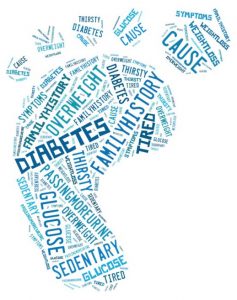1. What is diabetes?
Diabetes Mellitus, usually referred to as diabetes, is a common condition in which the amount of glucose (sugar) in the blood is too high because the pancreas (a gland behind the stomach) cannot make enough effective insulin.
The body needs glucose for energy, so everyone has some glucose in their blood all of the time. Insulin from the pancreas is needed to allow the body to use glucose for energy, so there needs to be some insulin in the blood all the time.
Diabetes means that either the pancreas does not produce any insulin (Type 1 Diabetes) or does not produce enough insulin or the insulin produced does not work properly (Type 2 Diabetes). This results in the level of glucose (sugar) in the blood being too high. Currently there is not a cure for diabetes, however it can be controlled.
Both types of diabetes have the same signs and symptoms, these are:
- Going to the toilet more frequently, passing a lot of urine, you often notice this more at night
- Increased thirst
- Extreme tiredness or loss of energy
- Weight loss
- Recurring infections e.g. thrush, urine infections, skin infections
- Blurred vision.
You may have noticed some of these symptoms before you were diagnosed with diabetes. They are signs of high blood glucose levels.
Type 1 diabetes
Type 1 diabetes develops when the body does not produce insulin because the cells in the pancreas that produce insulin have been destroyed. It is not known why this happens. The signs of diabetes develop quickly often over a few weeks. It usually affects children and adults below the age of 40.
People with Type 1 diabetes have stopped making insulin, therefore the body is unable to use the glucose that comes from the food they eat for energy, instead the body uses fat for energy. This leads to weight loss and signs of high blood glucose e.g. passing increased amounts of urine, being tired and thirsty. The signs of high blood glucose settle quickly once treatment is started.
Type 1 diabetes is treated with insulin injections, healthy eating and regular physical activity.
Type 2 diabetes
Type 2 diabetes develops when the body is not able to produce enough insulin to control the level of glucose in the blood, or when the body’s insulin does not work properly and the body resists the action of insulin. It usually affects people over the age of 35, but it can occur at a younger age. Type 2 diabetes is becoming increasingly common in the UK.

Factors which increase the risk of a person developing Type 2 diabetes include:
- Having a family history of diabetes
- Being over 40 years of age (your risk increases as you get older)
- Being of Asian, African or Caribbean descent
- Being overweight (particularly if you are bigger around the middle rather than being bigger around the hips)
- Having had diabetes during pregnancy or
- Doing little physical activity.
Type 2 diabetes develops slowly. Some people may not notice any symptoms at all and their diabetes is only discovered following a blood test. The symptom of tiredness may be put down to “overwork” or “getting older”.
Type 2 diabetes is treated by weight management, healthy eating, exercising regularly and medication (tablets/ injections may be required as the condition progresses). Blood glucose control deteriorates over time and therefore the treatment will need to change to keep blood glucose under control. This is not your fault but is due to the progressive nature of Type 2 diabetes. If you currently treat your diabetes with diet alone, you may need to start taking tablets in the future. If you already take tablets, your dose or the type of tablets you take may need to be increased and eventually you may need insulin injections. It is impossible to put
a time scale on this.

 When the starchy and sugary foods (carbohydrates) that we eat are digested they are broken down into glucose.
When the starchy and sugary foods (carbohydrates) that we eat are digested they are broken down into glucose.